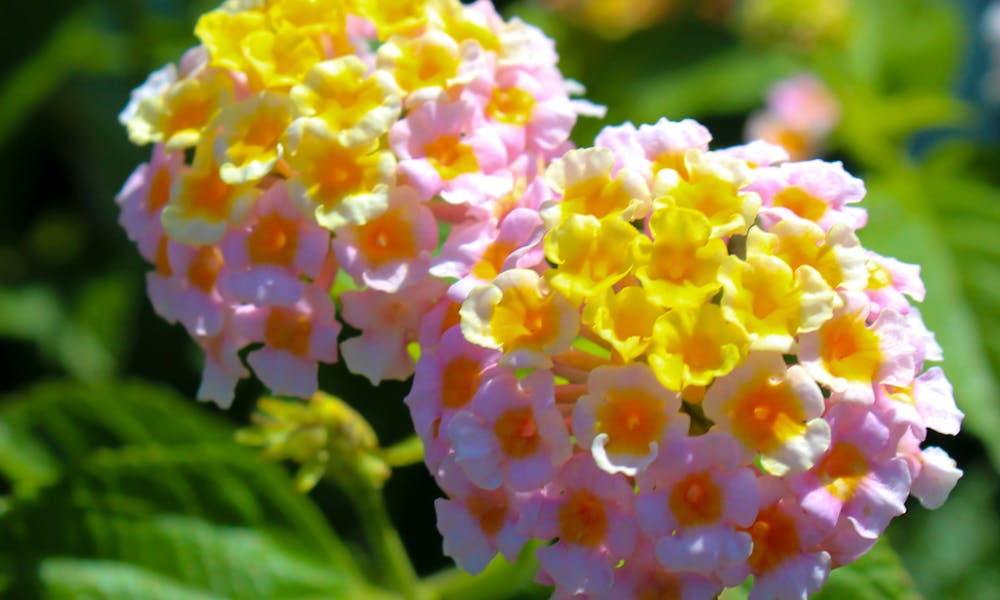Flowers are an amazingly colorful and perfumed gift from nature. They are this amazing mixture of deep, pure emotions and prettiness. Because they exist in a large variety of colors, scents, and forms, they are the best tool to bring bright colors and beauty into your life and your environment.
The flower we are going to talk about is lantana. Its family genus includes more than 150 species of flowering plants, but the Lantana Camara is the most common species. Native in the Americas and Africa, the lantana, which we know under various names depending on the host country, is a shrub naturalized in most tropical regions of the world. This plant produces very toxic fruits that are round and green before maturity. It can kill humans and many animals if they ingest them, so be aware of this if you decide to plant them within your garden.
In this article, the following points are going to be introduced:
- Generalities about the lantana flower
- What are the characteristics of lantana flowers?
- How to use lantana flowers?
- How to plant the lantana flowers?
Generalities About the Lantana Flower
This plant has a bad habit of occupying the space of other flowers. It’s a bit of a bully. Moreover, this plant produces very toxic green fruits for humans, and many animals, if ingested. Its foliage produces triterpenoids. They are organic compounds that are hepatotoxic and induce photosensitivity for grazing animals.
Paradoxically, this plant has some noticeable health benefits. The methanolic extract from the leaves of the lantana can facilitate the healing of gastric ulcers and prevent it. In Brazil, the extracts from fresh leaves are considered to have both antipyretic and carminative properties and are useful in the treatment of infections.
The local birds contribute to its dispersion. When the plant starts to grow somewhere, it can spread very quickly if the environment is suitable for them. Moreover, this flower is fire resistant, grows quickly in the burned areas, and even becomes a serious obstacle to the natural regeneration of other important indigenous species.
What are the Characteristics of Lantana Flowers?
The lantana is found naturally in America and Africa. Its name changes depending on the host country. It has become naturalized in most tropical regions of the world; it is found occupying fallow or cultivated spaces, seen around houses, and even escaping from the gardens.
The lantana camara, the most famous species of this family of flowers, is a shrub with quadrangular and thorny stems. The dark green, toothed, and slightly embossed leaves are truncated at the base and narrow at the top.
At the end of the spring, its flowering starts. Grouped in large umbels, the small tubular flowers form a mixture of round and colorful bouquets. There is one important phenomenon to know; when the flower opens, it is clear then slowly turns darker, so you can have a bouquet with yellow, orange and red flowers. The deciduous foliage of the lantana has, like its flowers, a sweet fragrance.
How to Use the Lantana Flowers?
The family of the lantana flowers includes several species and varieties of different growth habits. This flower has a very strong ability to grow rapidly and extend in a very fast way.
You can put this flower in a pot. If you are willing to put it in areas where space is limited, such as a window, a balcony, or a terrace, flowering in pots may be your best decision. The lantana camara can be very compact, thus adapting very well to a planter, pot, or basin. In a flowery composition, the compact varieties combine very well with other species, without becoming too large.
Lantana massif such as Lantana sellowiana, montevidensis or repens, are perfect in the foreground of a massif or as a hanging plant, in a tub, or large basin. Surprising and suitable for all types of culture, the lantana dazzles all summer long for lovers of pretty flowers!
How to Plant the Lantana Flowers?
Sow it during spring, between March-April, at 16-18 ° C, in terrain under shelter. It is necessary to plan a transplanting in pots when the seedlings have 4 to 5 leaves. You can then consider planting from mid-May when the risk of frost is eliminated. Keep 30 to 40cm distance between each plant.
For its perfect development, place the lantana a sunny location all year long. During summer, the lantana flower tolerates heat well, but during winter, it needs freshness. It is also frost-resistant, but also needs to be kept out of frost during the winter period. During March, you should make the “spring cut” to give it back its shape and flesh it out. As soon as the temperatures soften, you can take it out, but beware of the last frost! In October, bring it in or tear it out if you grow it as a seasonal one.
Flowers are an amazing gift from Mother Nature, full of surprises and wonders that never cease to surprise us. Among them, there are flowers, pure visual pleasures, and olfactory sweetness. With their bunch of forms, colors, and scents, they can give your garden and house a subtle touch of originality and beauty. They can also express whatever your heart may hide as feelings and accompany you for all occasions.
Let your lantana flowers seduce your visitors with their variety of colors. This flower is filled with beauty and is known for its resistance to summer dryness. However, growing it in pots requires regular watering, more so in the hot season than in the cold season. Additionally, it is very important for you to remember that this plant can be toxic if you ingest its green fruit, so be aware of that and put it away from your children.
